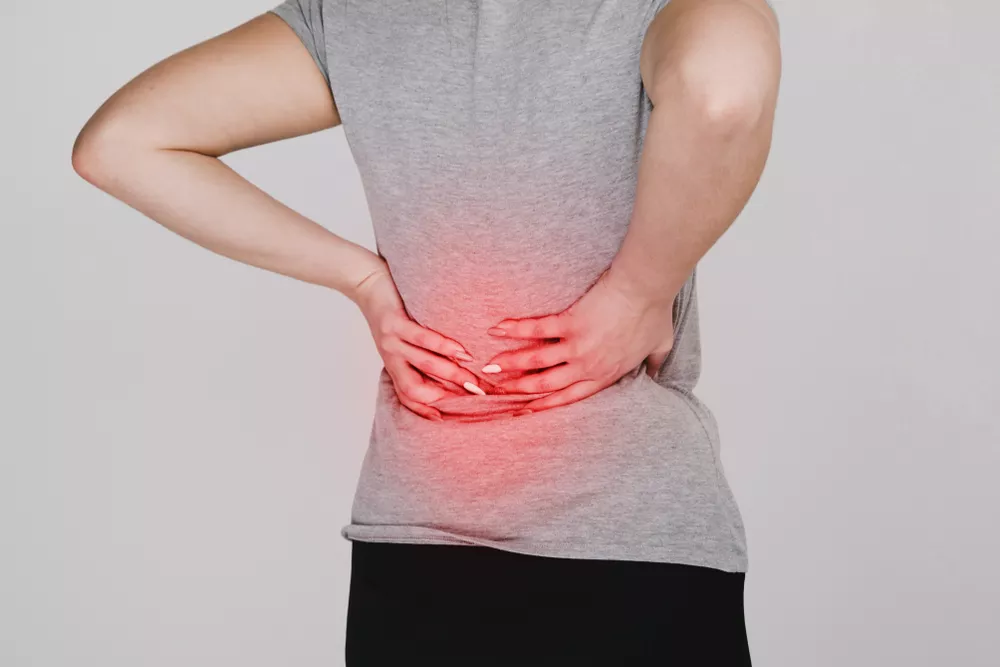What is Lumbago? Causes, Symptoms & Treatment

Table of Contents:
- Understanding Lumbago
- Causes of Low Back Pain
- Signs and Symptoms of Lumbago
- Treatment Options for Lumbago
- Minimally Invasive Surgery for Lumbago
- Tips for Preventing Lower Back Pain
- Conclusion
As we spend more time sitting in office chairs and watching TV, people find themselves inflicted with lumbago – a general term that describes pain in the lower back muscles.
If you’re suffering from acute or chronic pain in the lower back, you’re not alone. Lumbago is a prevalent condition that affects people of all ages and backgrounds. Studies have shown that up to 23% of adults worldwide suffer chronic low back pain. The good news is that effective lumbago treatments are available to help alleviate the discomfort and pain caused by this condition.
In this article, we will explore the common causes, symptoms, and treatment for lumbago. Plus, useful tips on how to prevent low back pain.
Understanding Lumbago
Lumbago is typically described as mild to severe lower back pain. Most people feel the pain most prominently near their spine, but it tends to radiate outward and can even feel like cramps in the buttocks, groin, and thighs.
In other cases, the cramps travel upward to the neck and shoulders, causing a stiffening sensation. This occurs because the muscles in the lower back are spasming, causing them to contract beyond your control, which puts pressure on the body and prevents you from moving freely.
Lumbago strikes sporadically, and you may experience bouts of pain-free living interrupted by a sudden onset of pain which takes a few weeks to heal. The pain can range from mild to severe, leading to significant limitations in daily activities and overall quality of life.
Lumbago with Sciatica
Lumbago can sometimes be accompanied by sciatica, which refers to pain that radiates along the path of the sciatic nerve–the largest nerve in the body. This condition occurs when the sciatic nerve is compressed or irritated, typically due to a herniated disc or bone spur in the spine.
The combination of these conditions can cause significant discomfort and limited mobility. Common symptoms include lower back pain that often goes down the buttocks and leg, numbing or tingling sensation in the leg or foot and weakness in the affected leg.
Treating lumbago with sciatica often involves a combination of conservative measures and medical interventions. Conservative methods may include rest, physical therapy, stretching exercises, hot or cold therapy, and over-the-counter medications. In some cases, doctors may prescribe muscle relaxants or stronger medications for pain relief.
If conservative treatments do not provide sufficient relief, more advanced medical interventions and surgical options such as discectomy or laminectomy may be considered to alleviate pressure on the sciatic nerve.
At Royal Spine Surgery, patients receive individualized care from experienced surgeons who take the time to understand each patient’s unique condition and develop personalized treatment plans tailored to their specific needs. This patient-centric approach ensures the best possible outcomes and higher patient satisfaction.
Need relief from lower back pain? Schedule an appointment with Royal Spine Surgery in Scottsdale, AZ!
Causes of Low Back Pain
Low back pain can have various causes, and understanding them is crucial for effective treatment and prevention. Some common factors that contribute to the development of lumbago include:
-
Muscle Strain
Overexertion or improper lifting techniques can strain the muscles and ligaments in the lower back, leading to lumbago.
-
Poor Posture
Prolonged sitting or standing with poor posture can place excessive stress on the lower back, triggering pain and discomfort.
-
Spinal Abnormalities
Conditions such as herniated discs, spinal stenosis, or degenerative disc disease can compress nerves and cause lumbago.
-
Injuries
Accidents, falls, or sports-related injuries can result in lumbago due to damage to the muscles, ligaments, or vertebra.
-
Medical Conditions
Underlying conditions like arthritis, osteoporosis, or fibromyalgia can contribute to lumbago.
-
Obesity
Excess weight can strain the lower back, increasing the risk of lumbago.
-
Psychological Factors
Stress, anxiety, and depression can exacerbate back pain and make it more challenging to manage.
Signs and Symptoms of Lumbago
Identifying the signs and symptoms associated with lumbago is essential for accurate diagnosis and timely treatment. The following are commonly experienced by individuals with low back pain:
-
Localized Pain
Localized pain is one of the most common symptoms of low back pain. It is primarily felt in the lower back region, although it can also affect the hips, buttocks, or legs.
-
Stiffness
Feeling stiff or having limited mobility in the lower back may be present, making it difficult to perform certain movements.
-
Muscle Spasms
Involuntary muscle contractions or spasms can occur, causing additional discomfort.
-
Pain Aggravation
Pain may worsen with certain activities such as bending, lifting, or prolonged sitting/standing.
-
Numbness and Tingling
Some individuals may experience numbness or tingling sensations in the legs or feet due to nerve compression.
Treatment Options for Lumbago
When it comes to managing lumbago, a multimodal approach combining various methods and techniques often yields the best results. Here are some effective strategies commonly employed:
Pain Medication
Over-the-counter nonsteroidal anti-inflammatory drugs (NSAIDs) can help reduce pain and inflammation associated with lumbago.
Physical Therapy
Targeted exercises and stretches prescribed by a physical therapist can strengthen the muscles, improve flexibility, and alleviate pain.
Hot and Cold Therapy
Applying heat or cold packs to the affected area can provide temporary relief and reduce inflammation.
Postural Correction
Maintaining proper posture while sitting, standing, and lifting can significantly reduce lumbar strain.
Weight Management
Maintaining a healthy weight through a balanced diet and regular exercise can alleviate pressure on the lower back.
Alternative Therapies
Techniques such as acupuncture, chiropractic adjustments, and massage therapy have shown promising results in managing lumbago.
Surgical Intervention
In severe cases, surgical options like discectomy or spinal fusion may be considered when conservative treatments fail to provide relief for chronic pain.
Treatment for lumbago varies widely depending on the cause and severity of the case. When the pain is at its worst, doctors often prescribe pain medications and steroids to help relieve pain and strengthen the muscles.
You may also use an ice pack or a heating pad to help your muscles relax, and your doctor may recommend special medical equipment or furniture to adjust your posture so that your lower back will feel less strain.
Minimally Invasive Surgery for Lumbago
Royal Spine Surgery specializes in minimally invasive spine surgery for chronic low back pain. These procedures involve smaller incisions, reduced muscle damage, and faster recovery than traditional open surgeries. Some common surgical procedures for lumbago include laminectomy, discectomy, and spinal fusion.
Royal Spine Surgery is a renowned medical center dedicated to providing state-of-the-art spinal care in Scottsdale, AZ, and beyond. Our clinic boasts a team of highly skilled surgeons with expertise in treating various spinal conditions, including lumbago.
Contact us today to experience the benefits of our cutting-edge technology and advanced surgical techniques. Our focus on optimal patient outcomes means improved precision and shorter hospital stays.
Tips for Preventing Lower Back Pain
Prevention is always better than cure. By incorporating these simple practices into your lifestyle, you can reduce the risk of developing lumbago:
-
Exercise Regularly
Engage in physical activities that promote back strength, flexibility, and overall fitness. Core exercises and regular stretches keep the muscles of the lower back healthy, and they will be less likely to spasm.
-
Maintain a Good Posture
Practice proper posture while sitting, standing, and performing everyday tasks to reduce strain on your back.
-
Lift Correctly
Remember to use your legs instead of bending your back when lifting heavy objects, and seek assistance if needed.
-
Take Breaks
If your job involves prolonged sitting or standing, take regular breaks to stretch and relieve stress on your lumbar spine area.
-
Use Ergonomic Support
Utilize supportive chairs, pillows, or backrests that promote proper spinal alignment.
-
Avoid Prolonged Inactivity
Regular movement and avoiding extended periods of inactivity can help prevent muscle stiffness and reduce the risk of lumbago.
-
Manage Stress
Engage in stress-reducing activities such as meditation, yoga, or hobbies to minimize the impact of psychological factors on your back health.
Regain Your Mobility and Comfort with Royal Spine Surgery
Lumbago is a growing problem among people of all ages. For the most part, it is a temporary condition that can be remedied with proper exercise and stretching. But for those who experience ongoing low back pain, more advanced treatments are available.
By understanding the causes of lumbago, recognizing its symptoms, and implementing effective treatments and preventive measures, you can take control of your back health and minimize the impact of lumbago on your daily activities.
Dr. Abdulhamid is an expert in treating chronic lumbago cases and can help you find a treatment and maintenance plan that will help you manage your pain and get the most out of your life.
Schedule a consultation with Royal Spine Surgery to learn more about spinal treatment options and proper exercises for strengthening your lower back muscles. Let us help you overcome lumbago and regain a pain-free life.
About The Author
-

Dr. Abdulhamid is a highly skilled and experienced board-certified neurosurgeon with a passion for providing exceptional spine care. He specializes in minimally invasive spine surgery and has a reputation for achieving outstanding results for his patients. His commitment to excellence and patient-centered approach have earned him the trust and respect of his patients and colleagues alike.
RECENT POSTS
Three Reasons to Turn to Physical Therapy for Back Pain
Did You Know: Your Diet Could Be Contributing to Back Pain?
Exploring the Types of Back Surgery: A Comprehensive Guide
What to Expect During Spinal Decompression Therapy
Tips on How to Maintain Good Spinal Health
How You Can Protect Your Lumbar Vertebrae
Reasons to Discuss Your Back Pain With a Doctor
Understanding Dorsalgia: Causes, Symptoms & Treatment
How to Relieve Lower Back Pain at Home
What is Lumbago? Causes, Symptoms & Treatment
What To Do When You Experience Neck Pain
What Is Ultrasonic Spine Surgery?
How to Do Back Exercises for Back Pain
Ouch! Lower Back Spasms - Causes and Treatments
Why Have I Developed Back Pain After Surgery?
The Purpose of Spinal Decompression Surgery
Three Common Causes of Lower Back Pain
How to Prevent Back Pain at the Office
The Best Ways to Sleep With Back Pain
5 Daily Exercises for Better Spine Health
Is Your Mattress Causing Your Back Pain?
Supporting Back Health While Golfing